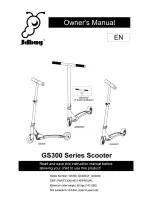
11
Riding in Cold Weather
Your escooter is designed to operate year-round. However, in very cold conditions or
when there is a lot of snow or slush on the ground, it is possible for the motor in the
escooter to get wet or for the brakes to function less effectively, just as it can happen
in wet weather. Below 10 degrees Celsius, the battery will not work as well as it would
in warmer temperatures. While Lithium-Ion batteries perform better than Lead-Acid
batteries in temperature extremes, both will experience reduced performance in cold
temperatures.
Also, riding the escooter in cold temperatures may require you to replace the battery
sooner rather than later.
Maximum Load
Do not exceed the maximum load capabilities of your scooter. You can find the exact
loading capacity listed in the technical specifications in this guide.
If you exceed the maximum load, the performance of the scooter will suffer.
Exceeding the maximum load of your escooter could cause damage to the shocks, to the
mechanism and, ultimately, even to the frame. It could also cause your motor to work too
aggressively, and may cause it to burn out.
Long-Term Storage of your E-scooter
If you are storing your escooter for a long period, disconnect the circuit breaker. This is a
safer way to store the electric scooter, as it prevents accidental activation of the e-scooter
and makes it impossible to activate it even with the key.
Please see the section titled “The Battery” for instructions on battery maintenance while
your escooter is being stored.










































